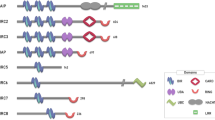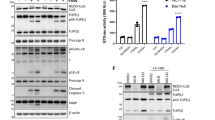Abstract
The widely expressed protein Fas is a member of the tumour necrosis factor receptor family which can trigger apoptosis1. However, Fas surface expression does not necessarily render cells susceptible to Fas ligand-induced death signals1,2, indicating that inhibitors of the apoptosis-signalling pathway must exist. Here we report the characterization of an inhibitor of apoptosis, designated FLIP (for FLICE-inhibitory protein), which is predominantly expressed in muscle and lymphoid tissues. The short form, FLIPS, contains two death effector domains and is structurally related to the viral FLIP inhibitors of apoptosis3, whereas the long form, FLIPL, contains in addition a caspase-like domain in which the active-centre cysteine residue is substituted by a tyrosine residue. FLIPS and FLIPL interact with the adaptor protein FADD4,5 and the protease FLICE6,7, and potently inhibit apoptosis induced by all known human death receptors1. FLIPL is expressed during the early stage of T-cell activation, but disappears when T cells become susceptible to Fas ligand-mediated apoptosis. High levels of FLIPL protein are also detectable in melanoma cell lines and malignant melanoma tumours. Thus FLIP may be implicated in tissue homeostasis as an important regulator of apoptosis.
This is a preview of subscription content, access via your institution
Access options
Subscribe to this journal
Receive 51 print issues and online access
$199.00 per year
only $3.90 per issue
Buy this article
- Purchase on Springer Link
- Instant access to full article PDF
Prices may be subject to local taxes which are calculated during checkout




Similar content being viewed by others
References
Nagata, S. Apoptosis by death factor. Cell 88, 355–365 (1997).
Klas, C., Debatin, K. M., Jonker, R. R. & Krammer, P. H. Activation interferes with the APO-1 pathway in mature human T cells. Int. Immunol. 5, 625–630 (1993).
Thome, M. et al. Viral FLICE-inhibitory proteins (FLIPs) prevent apoptosis induced by death receptors. Nature 386, 517–521 (1997).
Boldin, M. P. et al. Anovel protein that interacts with the death domain of Fas/APO1 contains a sequence motif related to the death domain. J. Biol. Chem. 270, 7795–7798 (1995).
Chinnaiyan, A. M., O'Rourke, K., Tewari, M. & Dixit, V. M. FADD, a novel death domain-containing protein, interacts with the death domain of Fas and initiates apoptosis. Cell 81, 505–512 (1995).
Muzio, M. et al. FLICE, a novel FADD-homologous ICE/CED-3-like protease, is recruited to the CD95 (Fas/APO-1) death-inducing signaling complex. Cell 85, 817–827 (1996).
Boldin, M. P., Goncharov, T. M., Goltsev, Y. V. & Wallach, D. Involvement of MACH, a novel MORT1/FADD-interacting protease, in Fas/APO-1- and TNF receptor-induced cell death. Cell 85, 803–815 (1996).
Bertin, J. et al. Death effector domain-containing herpesvirus and poxvirus proteins inhibit both Fas- and TNFR1-induced apoptosis. Proc. Natl Acad. Sci. USA 94, 1172–1176 (1997).
Bucher, P., Karplus, K., Moeri, N. & Hofmann, K. Aflexible search technique based on generalized profiles. Comput. Chem. 20, 3–24 (1996).
Fernandes-Alnemri, T. et al. In vitro activation of CPP32 and Mch3 by Mch4, a novel human apoptotic cysteine protease containing two FADD-like domains. Proc. Natl Acad. Sci. USA 93, 7464–7469 (1996).
Schuler, G. D. et al. Agene map of the human genome. Science 274, 540–546 (1996).
Walker, N. P. C. et al. Crystal structure of the cysteine protease interleukin-1-β-converting enzyme — a (p20/p10)(2) homodimer. Cell 78, 343–352 (1994).
Wilson, K. P. et al. Structure and mechanism of interleukin-1β converting enzyme. Nature 370, 270–275 (1994).
Vincenz, C. & Dixit, V. M. Fas-associated death domain protein interleukin-1β-converting enzyme 2 (FLICE2), an ICE/Ced-3 homologue, is proximally involved in CD95- and p55-mediated death signaling. J. Biol. Chem. 272, 6578–6583 (1997).
Kischkel, F. C. et al. Cytotoxicity-dependent Apo-1 (Fas/CD95)-associated proteins form a death-inducing signaling complex (DISC) with the receptor. EMBO J. 14, 5579–5588 (1995).
Gu, Y. et al. Interleukin-1β converting enzyme requires oligomerization for activity of processed forms in vivo. EMBO J. 14, 1923–1931 (1995).
Medema, J. P. et al. FLICE is activated by association with the CD95 death-inducing signaling complex (DISC). EMBO J. 16, 2794–2804 (1997).
Bump, N. J. et al. Inhibition of ICE family proteases by baculovirus antiapoptotic protein p35. Science 269, 1885–1888 (1995).
Xue, D. & Horvitz, H. R. Inhibition of the Caenorhabditis elegans cell-death protease CED-3 by a CED-3 cleavage site in baculovirus p35 protein. Nature 377, 248–251 (1995).
Bodmer, J. L. et al. TRAMP, a novel apoptosis-mediating receptor with sequence homology to tumor necrosis factor receptor 1 and Fas(Apo-1/CD95). Immunity 6, 79–88 (1997).
Marsters, S. A. et al. Apo-3, a new member of the tumor necrosis factor receptor family, contains a death domain and activates apoptosis and NF-κB. Curr. Biol. 6, 1669–1676 (1996).
Kitson, J. et al. Adeath-domain-containing receptor that mediates apoptosis. Nature 384, 372–375 (1996).
Yu, G. L. et al. Signal transduction by DR3, a death domain-containing receptor related to TNFR-1 and CD95. Science 274, 990–992 (1996).
Tartaglia, L. A., Rothe, M., Hu, Y. F. & Goeddel, D. V. Tumor necrosis factor's cytotoxic activity is signaled by the p55 TNF receptor. Cell 73, 213–216 (1993).
Pan, G. et al. The receptor for the cytotoxic ligand TRAIL. Science 276, 111–113 (1997).
Peter, M. E. et al. Resistance of cultured peripheral T cells towards activation-induced cell death involves a lack of recruitment of FLICE (MACH/caspase 8) to the CD95 death-inducing signaling complex. Eur. J. Immunol. 27, 1207–1212 (1997).
Hahne, M. et al. Melanoma cells express Fas(Apo-1/CD95) ligand: Implications for tumor immune escape. Science 267, 1363–1366 (1996).
Nagata, S. & Golstein, P. The Fas death factor. Science 267, 1449–1456 (1995).
Francis, M. J. et al. Immunological evaluation of the multiple antigen peptide (MAP) system using the major immunogenic site of foot-and-mouth disease virus. Immunology 73, 249–254 (1991).
Lowin, B., Hahne, M., Mattmann, C. & Tschopp, J. Cytolytic T-cell cytoxocity is mediated through perforin and Fas lytic pathways. Nature 370, 650–652 (1994).
Acknowledgements
We thank S. Belli for reading this manuscript; C. Servi for peptide synthesis; and R.Bullani, S. Hertig, M. Rousseaux and T. Bornand for technical assistance. This work was supported by grants of the Swiss National Science Foundation (J.T.) and the European Molecular Biology Organisation (to M.T.).
Author information
Authors and Affiliations
Corresponding author
Rights and permissions
About this article
Cite this article
Irmler, M., Thome, M., Hahne, M. et al. Inhibition of death receptor signals by cellular FLIP. Nature 388, 190–195 (1997). https://doi.org/10.1038/40657
Received:
Accepted:
Issue Date:
DOI: https://doi.org/10.1038/40657
This article is cited by
-
del(8p) and TNFRSF10B loss are associated with a poor prognosis and resistance to fludarabine in chronic lymphocytic leukemia
Leukemia (2023)
-
Harnessing TRAIL-induced cell death for cancer therapy: a long walk with thrilling discoveries
Cell Death & Differentiation (2023)
-
Mechanisms of PANoptosis and relevant small-molecule compounds for fighting diseases
Cell Death & Disease (2023)
-
CRISPR screens identify novel regulators of cFLIP dependency and ligand-independent, TRAIL-R1-mediated cell death
Cell Death & Differentiation (2023)
-
The role of cell death in SARS-CoV-2 infection
Signal Transduction and Targeted Therapy (2023)
Comments
By submitting a comment you agree to abide by our Terms and Community Guidelines. If you find something abusive or that does not comply with our terms or guidelines please flag it as inappropriate.



